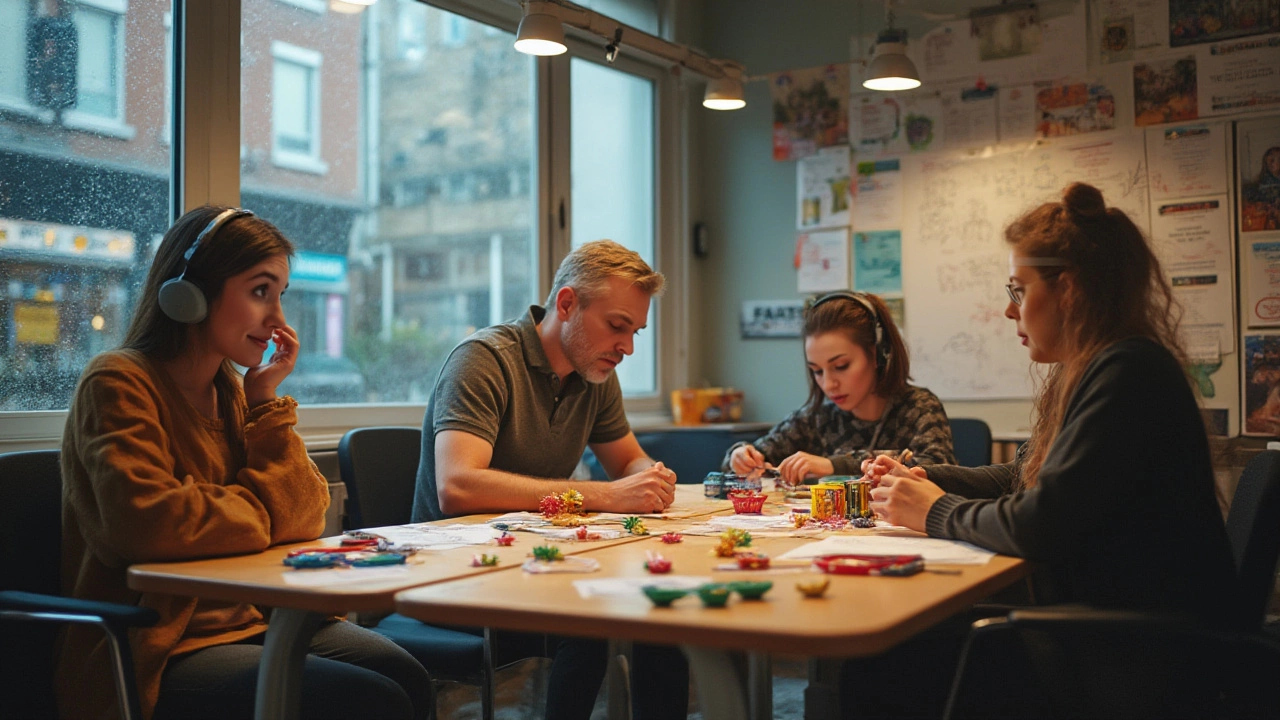Ever sat in a course, eyes glazing over, while everyone else seems to be scribbling notes frantically? Or maybe you've found yourself zoning out while someone drones on, but come alive the second you get your hands dirty trying something? Learning as an adult can feel like a whole different animal from back in your school days. It’s not about memorizing for an exam anymore – it’s about making information stick for real life, especially when time is short and responsibilities are calling. One thing not enough people talk about is how adults, just like children, don’t all learn the same way. Adult brains actually crave different paths to understanding, and knowing your own style can turn learning from a chore into something you’re actually good at. Here’s the deal: there are three core adult learning styles you should know about – visual, auditory, and kinesthetic – and they’re a lot more fascinating (and useful) than you might think.
Understanding Visual Learners: Seeing is Believing
Let’s be honest, visual learners get a bit of an edge in today’s swipe-and-scroll world. If you’re that person who remembers information better with diagrams, infographics, or mind maps, you might be a visual learner. Visual learners process and retain information best when it’s presented in a way they can see; think charts, photos, timelines, color-coded notes, and even physical gestures. Research from the University of California found that about 65% of people naturally prefer visual learning. Now, that’s a huge chunk.
If this sounds familiar, you’ll love tips like color coding your notes, using apps that let you sketch or organize ideas, or watching explainer videos over reading pages of plain text. The best part? You don’t have to be artistically gifted to benefit from visuals – stick figures and squiggles do the job! For many visual learners, the simple act of doodling in the margins helps cement facts in their mind. When attending workshops or lectures, looking for the PowerPoint, handouts, or even creating your own quick graphs can help with recall.
But don’t forget: too many visuals can flood your brain. If your notes are looking like an explosion of highlighters, try focusing on only the most vital bits to color-code or diagram. What’s powerful is how visuals connect new ideas to what you already know; your brain takes those mental snapshots, and suddenly, remembering what you heard last month is easier. Apps like Notion or OneNote are great for organizing visuals. If you’re prepping for a certification test, try mind mapping for the trickiest subjects – it’s visually connecting concepts, which helps them stick.
In companies, visual learners are often the ones volunteering to make the project poster or lead with slide decks. They also tend to remember faces and locations (like, say, which Dublin pub has the cosiest corner), but might blank out on names or dates if not written down. Realizing you’re a visual learner isn’t just useful for classes – it’s handy for everything from trip planning to learning a new skill at work. If you’re stuck, a quick sketch or looking up a diagram might just clear that mental fog.
Auditory Learners: The Power of Sound and Conversation
If you find yourself replaying podcasts rather than reading articles, or if a lively debate lights up your brain more than any handout ever could, you might land firmly in the auditory camp. Auditory learners grasp new concepts fastest by hearing, discussing, or even teaching others the information. Studies from The Open University in the UK suggest about 30% of adults lean on auditory methods. They’re not just those students nodding along in lectures; they’re the colleagues who prefer a good voice note to a mile-long email, and the mates who remember every word to that song from three summers ago.
For auditory learners, the rhythm and melody of language matter. They process information best when it’s spoken aloud, whether that’s through lectures, discussions, audiobooks, or, yes, podcasts. Many thrive in study groups, bouncing ideas off others and talking things through. This makes language courses or communication-heavy workshops a breeze for them. One practical tip? Try recording yourself summarizing new concepts. Listen back while walking, commuting, or cleaning up after dinner. This turns moments like bus rides into mini study sessions.
Even reading aloud quietly to yourself works wonders. Struggling with something at work? Talk it through with a trusted friend or out loud to yourself; hearing it helps you sort it. And don’t underestimate the power of rhythm – mnemonics or rhyming can flip tricky details into sticky ones. You might even catch your brain humming the multiplication tables, just like in school.
One challenge: offices and courses aren’t always designed with auditory learners in mind. Sometimes, information comes as a wall of text or endless spreadsheets. In those cases, try asking if meetings can be recorded, or set up a quick call instead of sending another email. Voice-to-text apps can also bridge the gap, helping you process written material by hearing it. Auditory learning is also a secret weapon for communication-heavy jobs; trainers, coaches, or therapists often score high here.
Social learners – a subtype of auditory learners – also benefit from collaborative projects. They might stay motivated through teamwork or regular check-ins. If you love workshops over solo reading, keep seeking out those opportunities. Just remember: background noise can be both a blessing and a curse, so find your sweet spot – maybe that Dublin coffee shop hum helps, or maybe you need complete quiet to soak up a podcast.

Kinesthetic Learners: The Need to Move and Do
If you’re happiest rolling up your sleeves, taking things apart to see how they work, or pacing as you brainstorm, then kinesthetic learning probably describes you perfectly. Kinesthetic learners – about 5% of the adult population, according to research at Trinity College Dublin – learn best by moving, touching, and doing. It’s hands-on or bust. The traditional sit, listen, and write method drives them up the wall. Instead, they come alive in practical workshops, field visits, and any task that lets them interact directly with the content.
Think about cooking – you can watch a video all day, but nothing replaces actually chopping, stirring, and tasting for learning the recipe. That’s kinesthetic learning in action. These learners benefit from writing notes by hand, drawing diagrams themselves, or using gestures when remembering information. Ever see someone walk while rehearsing a presentation? Or use Lego bricks to model a complex project plan? That’s textbook kinesthetic behaviour.
Kinesthetic strategies bring learning into the real world. Whether that means acting out scenarios, building models, or even just tapping your feet while thinking, the key is movement. Don’t fight the urge to fidget – controlled movement helps these learners focus better. Squeezing a stress ball, bouncing a leg under the table, or using a standing desk aren’t distractions for kinesthetic types; they’re tools. In workshops, find ways to get up, switch tables, or join interactive activities. If you’re learning digitally, look for simulation tools or online quizzes that require rapid responses or dragging-and-dropping pieces.
This style can be trickiest in situations that demand silence and stillness. If you’re forced into long Zoom meetings or note-heavy seminars, try typing responses or making your own summary flashcards as you listen. Exercise breaks or short walks before, during, or after studying can also help encode new info. Sports, drama, or dance classes are goldmines for kinesthetic learners. Even things like assembling flat-pack furniture, DIY projects, or gardening turn into opportunities for brain-friendly learning. And here’s a tip: acting out a tough bit of info, like a legal procedure or workflow, can make it click in ways staring at the page never will.
It’s worth noting – adults often study in ways that don’t suit them, just because that’s “how it’s done.” The best kinesthetic learners got there by breaking the mould and trusting that moving actually helps them remember. The next time you catch yourself pacing in circles while mulling a new concept, pat yourself on the back – you’re playing to your strengths.
Blending and Adapting: Why Flexibility Matters in Adult Learning
Here’s an interesting twist – very few adults are 100% visual, auditory, or kinesthetic. According to a 2022 survey by the Learning & Work Institute, over half of people describe themselves as “multimodal,” meaning they combine styles depending on context or task. That’s actually good news. Flexibility means you can adapt your approach based on what works best, rather than forcing yourself into a box.
This is where blended learning comes in. Let’s say you’re prepping for a professional exam. You might diagram key concepts (visual), listen to review podcasts (auditory), and work through interactive practice cases (kinesthetic). Mixing up your methods helps reinforce learning, keeps boredom at bay, and even strengthens memory. There’s a reason blended workshops are now the gold standard in industries from tech to healthcare.
Recognizing your lead style isn’t about limiting yourself – it’s about building a toolkit. Next time you face a tricky topic, ask yourself: have I tried looking at this in a different way? Sometimes, the breakthrough comes from switching modes, not pounding harder on the same one. For example, if you can’t get your head around a policy manual, try recording it and playing it back while you walk, or sketch a rough flowchart to show how one step leads to another.
For teachers, coaches, and managers, understanding this mix can make or break a training session. Designing materials that tap into all three major learning styles means nobody gets left behind. Look at the data below – you’ll see how common these learning style preferences are in adults:
| Learning Style | % of Adults |
|---|---|
| Visual | 65% |
| Auditory | 30% |
| Kinesthetic | 5% |
When you’re building a self-study plan, pepper in all three styles. Start with a quick mind map, talk through your plan with a friend, and then get hands-on with a real-life example. Adults juggling careers and family need every tool going. Apps like Quizlet let you do visual (flashcards), auditory (listen mode), and kinesthetic (typing your own content), so don’t be afraid to switch it up.
The beauty of adult education today is how customizable it’s become. Online courses now offer video, audio, and interactive labs all together. Community classes mix group work and hands-on demos. Hybrid workplaces use everything from video calls to physical whiteboards. No matter your preferred learning style, there’s a way to make it work in your favour.
Spotting your own style is the start, not the end goal. Once you know what makes learning stick, get creative and personalize your approach. If you’re not sure, experiment and see what leaves you remembering more the next day. After all, it’s your brain – you get to call the shots. The secret sauce of adult education is finding your own blend, and letting that make learning less of a slog and more of a skill you can actually enjoy. That’s real empowerment, no matter how old you are.
